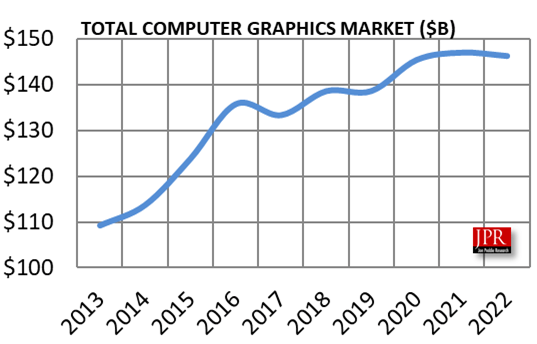
The computer graphics market saw rapid growth from 2013 to 2016 and has continued to wobble up since. Growth has slowed to an average (hardware and software) of 2% CAGR but at $150 billion a year that’s not trivial.
The accompanying chart shows the growth in hardware and software. The software aspects of the market have been slow to flat, but hardware segments have been varied, influenced by consumer products such as game consoles and PC gaming machines. Virtual reality, which has gained so much attention, is hardly a factor in either hardware or software, and despite some glowing forecasts, we don’t think it will be for a while. The main point of exploration for VR today is in content creation where it is used for virtual production, a glamorous but tiny market, and design for professionals, its traditional market.

Computer Graphics Hardware Market
The computer graphics hardware market was worth $125 billion in 2018 and is expected to increase to $133 billion by 2022, with software growing slightly and a little less than hardware.

Overall Computer Graphics Market
The hardware segment of the CG industry has seen steady overall growth, with some ups and downs due to product cycles and the irregularity of the PC market.
2018 saw the introduction of new GPUs and add-in boards (AIBs) with ray tracing capabilities, and several new CPUs, and upgraded game consoles also were introduced.
The market for CG software in 2018 was worth $14 billion (not counting services, maintenance and other aspects) and is expected to grow to $17.3 billion by 2022 as the industry shifts its sales model moving more services to the cloud, and transitioning to a subscriber system.
Although it doesn’t get discussed much, the digital graphics market is dominated by CAD/CAM. Even digital video is a bigger market than the modeling or rendering segments and yet when one reads about CG it’s all about the special effects in games and movies. That’s easy to understand. Everyone loves VFX and has experienced it. In reality, truly amazing things are happening in CAD as the digital and real get connected. CAD has taken a leap and it shows in increased revenues for all companies. And, although unsung, CAD is often involved in the heavy lifting of all those 3D models of cities and spaceships. The beautiful ray-traced images of automobiles, gorgeous skyscrapers, and clothing, bottles, and other consumer goods – it’s all CG.

Computer Graphics Software Market
The demand for programmers, artists, scientists, and designers continues to be strong and we’re seeing startups arrive in emerging and reborn markets such as augmented reality, virtual reality, and casual games. Artificial intelligence is playing an ever bigger role in image processing, ray tracing, and AR. The arrival of new APIs, and platforms are also stimulating development. Firms are actively looking for people who can use and exploit these new programs and their associated hardware accelerators.
Given the trends in dropping costs, and the increasing users and usage of CG tools and hardware, we predict that the rate of growth for the CG industry will remain fairly steady for the foreseeable future. Computer graphics is truly a worldwide industry now. JPR will have a press only discussion on this topic at SIGGRAPH in Marriott Live at noon-all press and analysts are invited.
About Jon Peddie Research
Dr. Jon Peddie has been active in the graphics and multimedia fields for more than 30 years. Jon Peddie Research is a technically oriented multimedia and graphics research and consulting firm. Based in Tiburon, California, JPR provides consulting, research, and other specialized services to technology companies in a variety of fields including graphics development, multimedia for professional applications and consumer electronics, high-end computing, and Internet-access product development.
Jon Peddie’s Market Watch is a quarterly report focused on the market activity of PC graphics controllers for notebook and desktop computing.

熱門頭條新聞
- OIAF2025
- Once Human Launching Three New Scenarios & Mobile Version In 2025
- ‘Memoir of A Snail’ to Open Anima Festival 2025
- New STALCRAFT: X Game Mode Revealed in New Trailer Showcased at The Game Awards
- Can CD Projekt Recapture the Magic?
- Meridiem announces physical edition of the paw-some Cats on Duty for PlayStation 5
- Chart a Course for Puzzle Adventure in Tile Tales: Pirate!
- Czech Game of the Year
